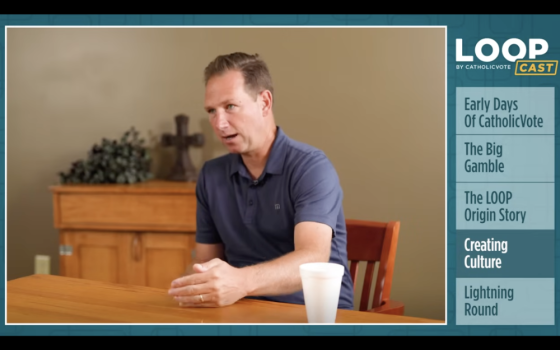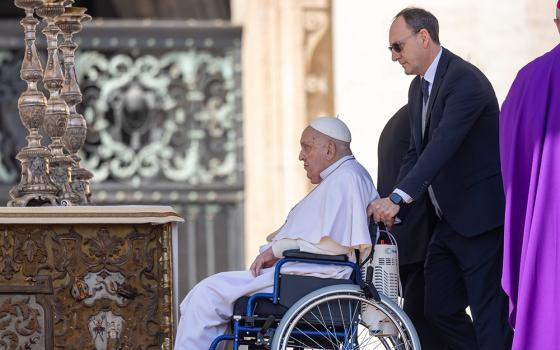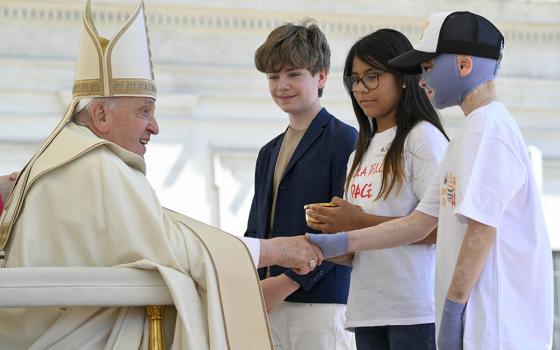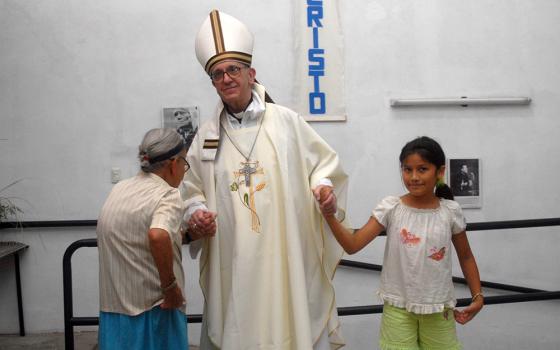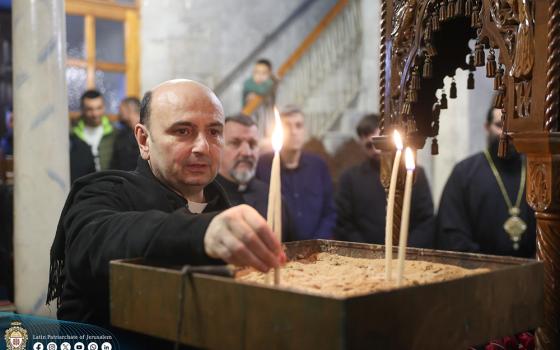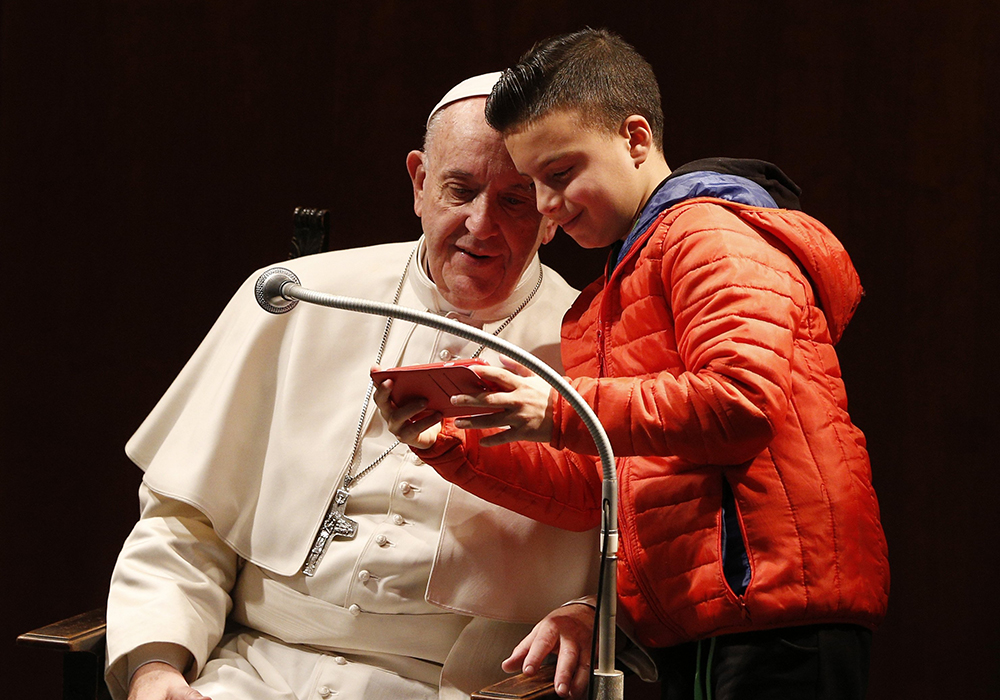
A boy takes a selfie with Pope Francis as the pope meets children before celebrating Mass at St. Mary Josefa Parish in Rome on Feb. 19, 2017. (CNS/Paul Haring)
On March 13, 2013, even before the new pope appeared on the loggia of St. Peter's minutes after being elected, the first inkling that his would be a different kind of pontificate, and a stunning inkling at that, was his choice of name: Francis.
He was the first pope to take the name of the beloved medieval saint whose commitment to poverty and to the poor commenced the greatest reform in the long history of the church. We would later learn that the choice of name was inspired by his friend Brazilian Cardinal Claudio Hummes who, once his election became clear, whispered to him, "Don't forget the poor." He never did.
One way to understand this pontificate is to view it as a gradual unpacking of the significance of his choosing the name Francis.
When Pope Francis came out onto the loggia a few minutes later, he began with the words, "Fratelli e sorelli, buona sera. Brother and sisters, good evening." He was introducing himself to his new worldwide flock not as the sovereign pontiff but as a brother, and fraternity would be a theme of his magisterial teachings. The common greeting "buona sera" displayed a common touch, as did his appearance in a simple white cassock. Here was an approachable, quotidian personality, more pastor than prophet, a man who intended to accompany the people of God. And he always did.
A hermeneutical key of this pontificate was the practice of accompaniment, regardless of a person's ideas or status or, most especially, their sins. He seemed ever conscious of the fact that God is already active in each and every life, often in ways that are opaque to the rest of us.
That first night, Pope Francis led the assembled crowd in the Our Father, the Hail Mary, and the Glory Be, prayers even a child would know. He asked the people to bless him before he imparted his first apostolic blessing. As he bowed to receive the people's blessing, the crowd fell silent. It isn't easy to get tens of thousands of people to go silent, but silent they were.
Later, in what became the apotheosis of his reform agenda, the pope convened two synods dedicated to inviting us Catholics to shut up for a minute and listen to the Holy Spirit. As he always listened to the Holy Spirit.
In a noisy and busy world, in a time of cultural and political polarization, Pope Francis invited us all to listen to the quiet promptings of the Holy Spirit.
The first pope from the Global South, the pope challenged those of us in the wealthy Western nations to examine our lives and our luxuries, especially the luxury of endless debates about what does and does not make one a good Catholic. "Todos, todos, todos," became a theme of his ecclesiological vision, but he never failed to remind us that in the kingdom of God, it is the Lazaruses of the world (cf. Luke 16:19-31), the poor and forgotten who are privileged and that it remains easier for a camel to pass through the eye of a needle than for a rich man to get into heaven.
Decades and centuries hence, the election of the Archbishop of Buenos Aires, Cardinal Jorge Mario Bergoglio, as pope will be seen as a turning point, a confirmation that the center of gravity in global Catholicism had moved south of the Equator. The implications of that shift are difficult to discern, but one thing is obvious: Catholicism will again be a church of the poor.
The first Jesuit pope was, like most Jesuits, a teacher, but so much of Pope Francis' teaching was achieved by gestures. Early in his pontificate, he ordered the popemobile to stop so he could embrace a man whose body was severely deformed. Pope Francis, moved by the plight of migrants, made his first papal trip to Lampedusa, the island halfway between Tunisia and Malta where many Arab and African migrants landed in search of a better life. In all his papal trips he made visiting the poor a priority and, in a nod to his Jesuit identity, always had a gathering with the local community of the Society of Jesus. The transcripts of his visits with his fellow Jesuits always revealed a man deeply rooted in his Ignatian identity.
Francis' magisterium was more homey, more accessible, than that of his predecessors and it represented the turn to the pastoral in theology that mirrored his turn to the pastoral in his conception of his role as Bishop of Rome. Tomorrow, we shall look at that magisterium in greater detail.
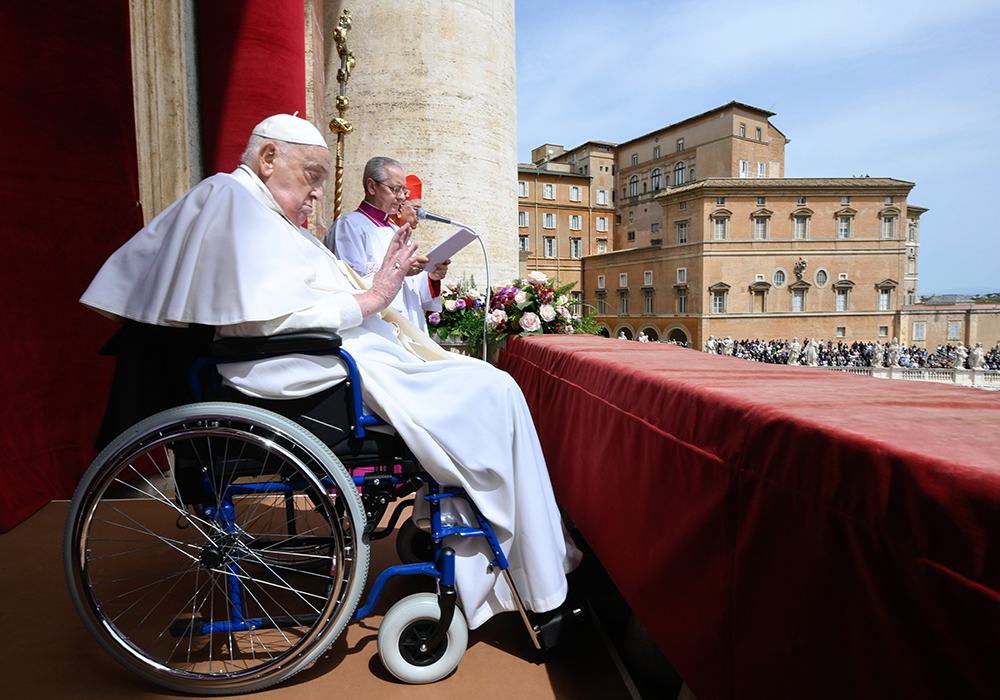
Pope Francis appears on the central balcony of St. Peter’s Basilica to deliver his Easter blessing "urbi et orbi" (to the city and the world) at the Vatican on April 20, 2025. (CNS/Vatican Media)
Conservative critics of the pope warned he was spreading confusion. In fact, most people understood exactly how the pope was trying to reorient the church's moral compass away from a singular focus on sexual sins as uniquely consequential and, just as important, reminding us all that God's grace is showered on us because we need it, not because God is giving us a prize for good behavior. There were plenty of conservative thinkers who supported the pope, such as Rocco Buttiglione, whose response to the dubia raised by four conservative cardinals against Amoris Laetitia detailed their errors, not the pope's.
Similarly, despite the opposition to Pope Francis from some U.S. bishops, most notably former Philadelphia Archbishop Charles Chaput, one of the most conspicuously conservative prelates in the U.S., Boston's Cardinal Sean O'Malley, became one of the pope's closest advisers.
The pope's opponents on the right clustered around the leadership of EWTN and Tim Busch's Napa Institute. The fifth floor at the bishops' conference building, where the executive offices are, became a Francis-free zone. Social media influencers, who have more attitude than theological training, were quick to denounce Pope Francis as heretical and considered disgraced former nuncio Carlo Maria Viganò as their champion, the alt-right of Catholicism.
Liberal critics failed to understand how Francis could be so welcoming of previously shunned groups like gay and transgender Catholics, while also refusing to overturn the church's moral traditions. The reactions to Dignitas Infinita exhibited a repulsive intellectual claim in some liberal circles, the idea that if you want to affirm a person's dignity, you must agree with that person's ideas or ideology. This is nonsense, of course, but the claim was widespread. It is a grim irony that the pope, in defending the church's moral tradition, managed to anger the extremes on both the left and the right, a pretty good indication he got it correct.
Advertisement
The pope had his weaknesses, to be sure, and as the cardinals gather in Rome to select his successor, their assessment of the needs of the church will spell out Francis' limitations and failings. I will only note one item now: It is remarkable that not since Pope Paul VI died in 1978 have we had a pope who really managed through the Curia, rather than around them. This is not sustainable.
Of all the many qualities of this extraordinary man, Francis had a knack for engaging children. As I think back over the past 12 years, the most quintessential moment of this papacy came on a parish visit. A little boy, Emanuele, went to the microphone to pose his question to the pope, but the boy was consumed with tears. The pope beckoned him — "Vieni, vieni" — and embraced him for a long time. The little boy whispered his question to the pope: He wanted to know if his father, who was an atheist and recently died, had gone to heaven. The pope assured the boy that God does not abandon a good man.
What really showed how Pope Francis was able to embody our dogmatic belief in the dignity of every human person, was this: Before he shared the boy's story, the pope said, "If only we could cry like Emanuele when we have pain in our hearts." Francis pointed out how even a little boy's tears can humanize us and, in a way, evangelize us. Francis also noted that he had asked Emanuele's permission to share his story with the gathered community, a profound mark of respect for the little boy's dignity. In this long pontificate, filled with so many beautiful moments, his encounter with Emanuele was the one that most touched my heart.
I am not someone who cries easily but I confess I have gotten choked up several times while trying to pen this reflection on his papacy. Watching the video of Pope Francis with little Emanuele opened the floodgates. Everyone admired Pope Benedict for his soaring intellect, and Pope John Paul II for his courage and tenacity. Pope Paul VI was the greatest pope of the 20th century, the man who brought Vatican II to a successful conclusion and began its implementation. Not since 1963, when Pope John XXIII died, has the Catholic world mourned a pope not primarily with admiration, but with affection. Francis touched our hearts.
Tomorrow, at Mass, we will not pray for "Francis, our pope" in the Eucharistic prayer. During this "sede vacante" period, more than the "sede" is vacant. It feels like Pope Francis has taken a piece of our hearts with him. I think he would scold me for voicing such a thought. Just as he deplored a self-referential church, he would not want us thinking about him at this moment, but about the Christ to whom he entrusted his soul and who will receive him into glory. With our heads, we grasp that. With our hearts, we aspire to that. But first, like little Emanuele, we all need the courage to cry.


